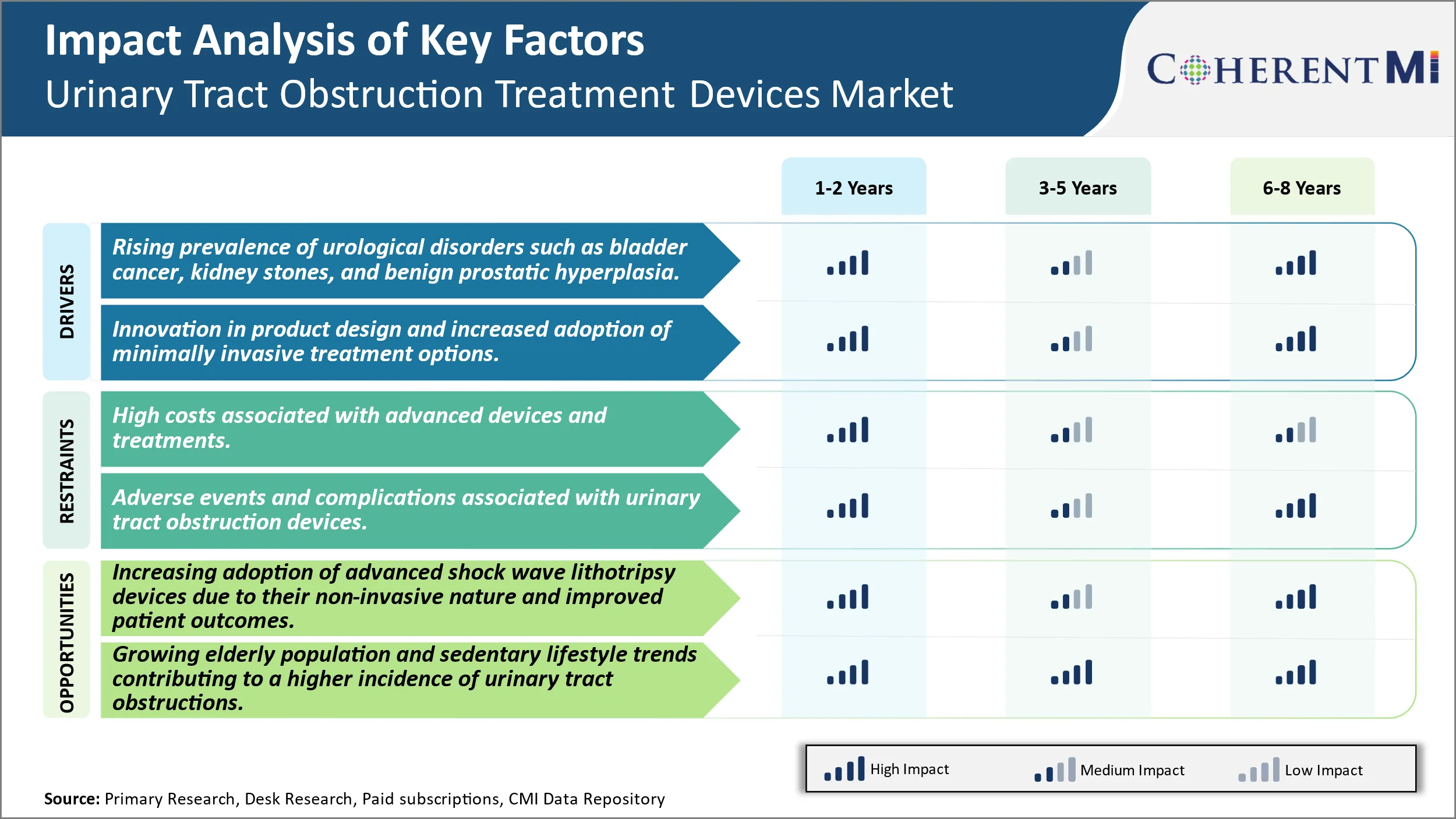Urinary Tract Obstruction Treatment Devices Market Trends
Market Driver - Rising Prevalence of Urological Disorders Such as Bladder Cancer, Kidney Stones, and Benign Prostatic Hyperplasia.
There has been rising prevalence of various urological disorders such as bladder cancer, kidney stones, and benign prostatic hyperplasia. Bladder cancer is one of the most common cancers, with high recurrence rates. According to some studies, the global incidence of bladder cancer is projected to rise by 11% in the next decade. Similarly, the prevalence of kidney stones is also increasing worldwide mainly due to changing dietary habits, lifestyle factors and growing prevalence of obesity and metabolic disorders. However, benign prostatic hyperplasia (BPH) remains the most common prostate problem in aging males, especially in developed countries with rising geriatric population. As men age, the prostate may continue to grow in size and can irritate the bladder and urethra causing various lower urinary tract symptoms. With an increasing emphasis on early diagnosis and management of these disorders, the use of urinary tract obstruction treatment devices is likely to gain widespread adoption. These devices help in removing obstructions in the urinary tract, thus improving urine flow and relieving symptoms. If left untreated, these obstructions can cause several other complications and deteriorate the quality of life. Various minimally-invasive procedures using devices are now the standard of care for managing bladder outlet obstruction and upper tract obstructions.
Market Driver - Innovation in Product Design Encourages Market Growth in the Forecast Period.
Over the past few years, there have been major advancements in the design of urinary tract obstruction treatment devices with an increasing focus on patient comfort and experience. Companies are continuously innovating and introducing less invasive devices with improved efficacy. For instance, new laser technologies, resection techniques and altered designs of ureteral stents and nephrostomy catheters have allowed interventions as outpatient procedures with quicker recovery times. Similarly, various modified TURP (transurethral resection of the prostate) devices now use advanced laser, water vapor or other energy sources instead of traditional electrosurgery. This enables targeted removal of prostatic tissue with reduced risks of complications such as bleeding. Likewise, newer lithotripters and navigate systems have streamlined the treatment processes for kidney stone management. Miniaturization of equipment size has also facilitated office-based procedures. With positive clinical outcomes, reduced hospital stays and faster return to normal activities, these new minimally-invasive options are gaining widespread popularity among both patients and physicians. Overall, innovations expanding the range of treatment choices while improving safety, efficacy and experience are likely to drive the future demand for cutting-edge urinary tract obstruction treatment devices.

Market Challenge - High Costs Associated with Advanced Devices and Treatments.
The urinary tract obstruction treatment devices market face significant challenges due to the high costs associated with advanced treatment options. Devices used for complex urinary tract obstruction treatments such as ureterorenoscopes, lithotripsy devices, and baskets and forceps require substantial capital investment, which places significant financial burden on healthcare providers. Additionally, new and innovative devices often come with high price tags in the initial years due to costs associated with research and development. This passes additional costs to the patients and insurers. The high overall treatment costs often discourage widespread adoption of new, advanced technologies. For many patients in underdeveloped or developing countries, the steep costs of newer minimally invasive and robot-assisted procedures make them inaccessible. Even in developed markets, high deductibles and co-insurance requirements deter patients from opting for expensive treatments. Given the budget constraints faced by most healthcare systems worldwide, high treatment costs pose a major barrier to the growth of the urinary tract obstruction treatment devices market.
Market Opportunity: Increasing Adoption of Advanced Shock Wave Lithotripsy Devices Due to Their Non-Invasive Nature and Improved Patient Outcomes.
The urinary tract obstruction treatment devices market possesses significant growth opportunities arising from increasing adoption of advanced shock wave lithotripsy (SWL) devices. SWL provides a non-invasive option for the treatment of urinary tract stones and obstructions. The procedure causes significantly less post-operative pain and recovery time for patients as compared to traditional invasive surgeries such as ureteroscopy and percutaneous nephrolithotomy. Advanced SWL systems also offer higher success rates and require fewer repeat treatments than traditional lithotripters due to improved imaging, targeting accuracy, and pulse control. Driven by their compelling clinical benefits over alternative treatments, newer generation lithotripters with advanced features have been witnessing rising installation base across healthcare facilities. As patient awareness increases regarding advantages of SWL such as shorter hospital stay and quicker return to regular activities, its adoption rate is expected to climb further over the forecast period. This will likely propel the sales revenues of urinary tract obstruction treatment devices producers.